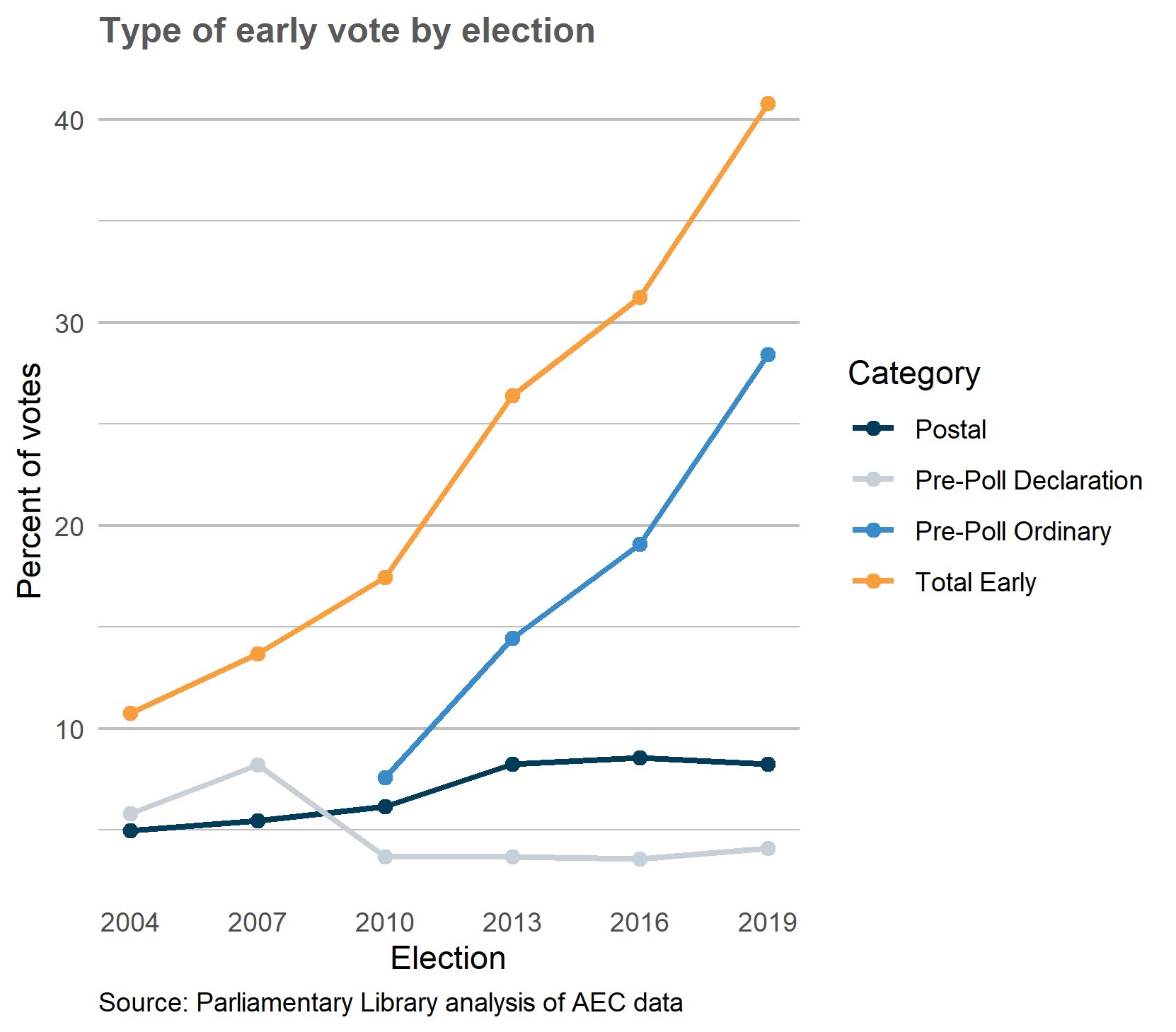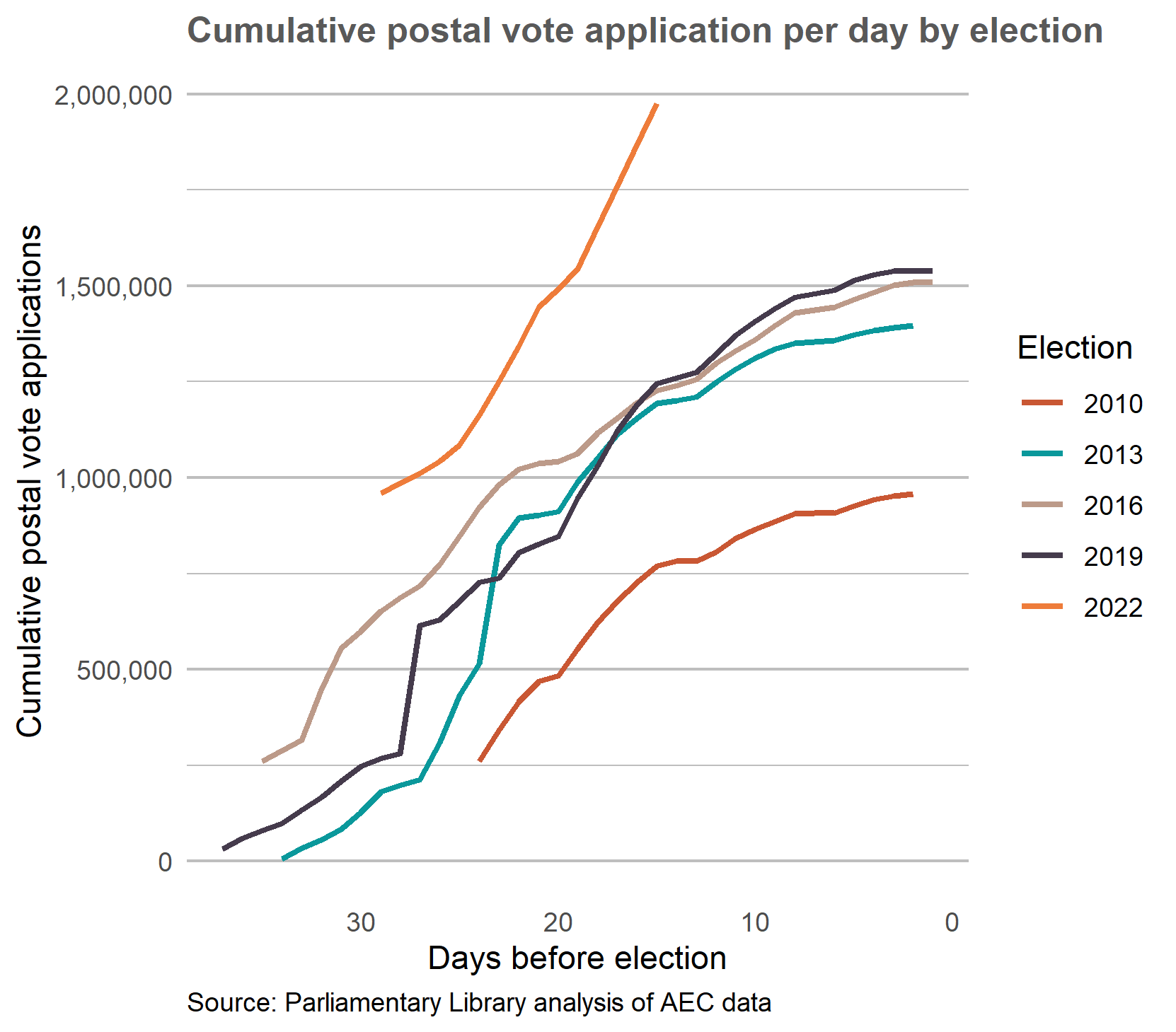Posted 06/05/2022 by Damon Muller
Australians have embraced early voting with considerable enthusiasm over the last several federal elections. At the 2019 federal election, early votes—mostly driven by the steady rise in pre-poll ordinary votes (votes before election day cast at a pre-poll or early voting centre)—constituted over 40 per cent of all votes. If the trends continue, up to half of all votes might be cast before the election day in 2022.

The continuing rise in early votes has been of concern to political parties, which must now account for it in their campaigning. Following the 2019 federal election the parliamentary Joint Standing Committee on Electoral Matters (JSCEM) recommended that the pre-poll period be limited to a maximum of two weeks (Recommendation 8). The JSCEM noted that ‘a two week period best balances the opportunity to participate in an election as a voter, with the logistic demands placed on those who participate as contestants’.
In 2021 the Parliament passed legislation to enact that recommendation, requiring that early voting start no more than 12 days before the election. Prior to this, early voting commenced four days after the date for the declaration of nominations, which had resulted in pre-poll periods of around three weeks in recent elections. Early voting will be available for the 2022 federal election from 9 May 2022.
In the many elections that have been run in the states and territories since the beginning of the COVID-19 pandemic, early voting has been an important strategy for minimising crowding on polling day. The Government introduced the Electoral Legislation Amendment (Contingency Measures) Act 2021, recognising the possibility of the need to expand early voting due to the COVID-19 pandemic. The legislation empowered the Electoral Commissioner to expand the period of pre-poll voting, though only to the length of time it was prior to the 2021 changes, and to expand the grounds for application for a pre-poll or postal vote. These measures only apply if an emergency is declared, which is not currently the case.
So far, the Australian Electoral Commission (AEC) has seen rates of postal voting applications that have well exceeded recent elections. Part of the increase is likely due to the pandemic and concern about attending a polling place in person, but some is also due to postal vote campaigns being run by political parties.
The AEC has taken the unprecedented step of warning voters against party-supplied postal vote applications, stating that ‘It’s legal but it is potentially misleading and we’re concerned.’ In evidence to a Senate Estimates hearing in April 2022, the Electoral Commissioner stated:
We're very confident with the postal vote process, but my view is that the act requires people to vote on the day unless there's a reason for them not to vote. … Then the third option is, of course, postal voting, which is a regular part of the Australian vote. … But I'm very keen on this being as normal as it possibly can be. One of the reasons is that the fewer votes in envelopes, the quicker the result will be known and the more likely it is that we'll have a result on the night or close to on the night, depending on how many postal votes there are.
Amendments due to the Electoral Legislation Amendment (Counting, Scrutiny and Operational Efficiencies) Act 2021 will also now allow the AEC to do some of the initial processing of postal votes and other declaration votes up to five days before election day (pre-poll ordinary votes are generally counted on election night, though due to the size of some of the pre-poll centres the results may only be available late on election night).[1] This should speed up the count of postal votes after polling day, but the AEC does not expect to count any postal votes on election night. Even in the absence of expedited processing, electoral law requires the AEC to count postal votes that are received for up to two weeks after election day to account for delayed mail delivery, potentially resulting in a drawn-out count.

Not everyone who applies for a postal vote will end up lodging a postal vote. Some people will apply just in case but end up voting at a polling place. So, the number of postal vote applications is not an exact predictor of actual postal voting rates, but Parliamentary Library analysis indicates that around 80% of the people who applied for a postal vote used that vote in the last three federal elections. Since 2010, the rate of postal vote applications has slowed in the last two weeks before the election, but even allowing for this it would be not surprising if we saw around 2 million postal votes in 2022 (though the AEC seems well prepared for such numbers).
The extent to which early voting affects when the declaration of the election results is made is impossible to predict in advance. Many of the state and territory elections which have been conducted since the start of the COVID-19 pandemic have also featured high levels of postal and pre-poll voting, but they have generally not had to wait for the last postal vote to arrive before the results could be declared. However, in the case of a close federal election, it is certainly possible that the next government might be decided by the last few postal votes as they trickle in two weeks after polling day.
[1] This post was updated on 18 May 2022 to reflect that the amendments to the Commonwealth Electoral Act 1918 to allow the AEC to undertake initial processing of declaration votes prior to polling day were enacted by the Electoral Legislation Amendment (Counting, Scrutiny and Operational Efficiencies) Act 2021, not as originally stated the Contingency Measures Act.